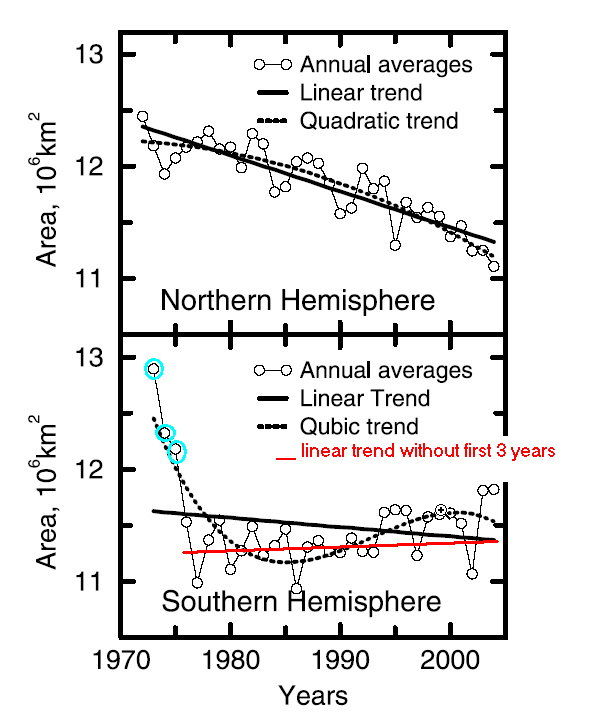| Sea-Ice extent: how to get your favorite trend |
Francis Massen
20 May 2006
file: sea_ice_extent_favourite_trend.html
In GRL (Geophysical Research Letters) Vol.33, published 03 March 2006, Vinnikov et al. [1] present a model assessment of the polar sea ice trends observed by satellites from 1972 to 2004. This paper contains a figure which shows how to select data points to get the trend you want to see. In this case, the authors, in true politically correct fashion, wanted to see decreasing trends for both hemispheres. There is no doubt that Arctic sea ice surface shrank in a more or less regular manner from 12.5 to about 11.2 million km2 ( -10%) in this period; the picture however is quite different for Antarctica. After a sudden plunge during the first 3 years (1973 to 1975) of the available satellite data, the sea ice extent began a slow recover, with a positive trend up to 2004.

figure 1 from Vinnikov et al. paper
Why did the authors blatantly ignore this fact, and stick to their negative linear trend caused by only 3 years (1973, 1974, 1975) out of 31 ? The authors write correctly that "(southern) sea ice no longer has a positive trend once the data from early and mid 1970's are included", and thus suggest a worsening situation starting 1973 and still going on (the cubic interpolation with it's big starting plunge reinforces this false impression). A minimum of scientific rigor and honesty would have told them NOT to include these data, where the 3 first years force a negative trend on a series of 28 following years that show sea ice extent on increase; they should have reported that contrary to the Arctic, Antarctica sea ice extent as measured from the satellites is increasing, and that the extension to the full series does not give a better insight. Let us just take their remark that "the SH negative least squares fit line is not statistically significant" as a small pay-back.
Cherry-picking at it's best!
Reference:
[1] Vinnikov,
Cavalieri, Parkinson: A model assessment of satellite observed trends in
polar sea ice extents. GRL Vol.33, L05704
[2] CO2Science
:North and South Polar Sea Ice Extents